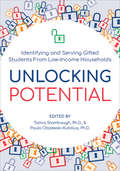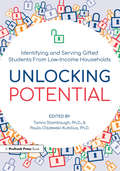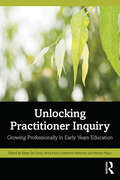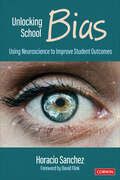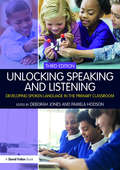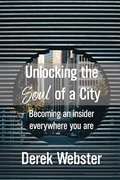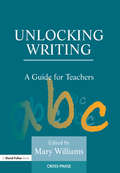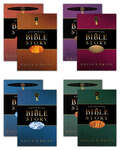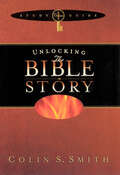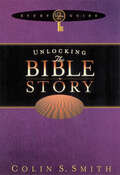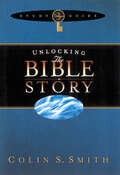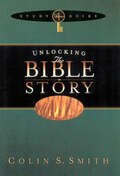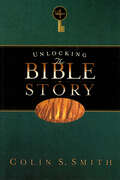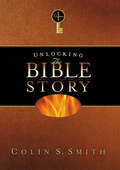- Table View
- List View
Unlocking Potential: Identifying and Serving Gifted Students From Low-Income Households
by Paula Olszewski-Kubilius Tamra StambaughThis edited book, written by authors with extensive experience in working with gifted students from low-income households, focuses on ways to translate the latest research and theory into evidence-supported practices that impact how schools identify and serve these students. Readers will:Learn about evidence-supported identification systems, tools, and strategies for finding students from low-income households.Discover curriculum models, resources, and instructional strategies found effective from projects focused on supporting these students.Understand the important role that intra- and interpersonal skills, ethnicity/race, families, school systems, and communities play.Consider the perceptions of gifted students who grew up in low-income households.Learn how educators can use their experiences to strengthen current services.Unlocking Potential is the go-to resource for an up-to-date overview of best practices in identification, curriculum, instruction, community support, and program design for gifted learners from low-income households.
Unlocking Potential: Identifying and Serving Gifted Students From Low-Income Households
by Paula Olszewski-Kubilius Tamra StambaughWinner of NAGC's 2021 Book of the Year Award This edited book, written by authors with extensive experience in working with gifted students from low-income households, focuses on ways to translate the latest research and theory into evidence-supported practices that impact how schools identify and serve these students. Readers will: Learn about evidence-supported identification systems, tools, and strategies for finding students from low-income households. Discover curriculum models, resources, and instructional strategies found effective from projects focused on supporting these students. Understand the important role that intra- and interpersonal skills, ethnicity/race, families, school systems, and communities play. Consider the perceptions of gifted students who grew up in low-income households. Learn how educators can use their experiences to strengthen current services. Unlocking Potential is the go-to resource for an up-to-date overview of best practices in identification, curriculum, instruction, community support, and program design for gifted learners from low-income households.
Unlocking Practitioner Inquiry: Growing Professionally in Early Years Education
by Alma Fleet Catherine Patterson Katey De Gioia Marina PapicKey components of practitioner inquiry provide an effective approach to lasting educational change. By including narratives of practice from across diverse early childhood settings, this book investigates issues that arise during implementation of inquiry-focussed professional learning cycles. It presents practitioner inquiry as a vehicle for empowering educators and educational systems. Research-based, this book brings together theory and practice from authors and internationally recognised commentators to inform and inspire early childhood educators. Chapters are thematically grouped in three focus areas. The first centres on background contextual information to set the scene, the second offers real-life stories based on authors’ experiences and the third provides insight into broader issues of leadership and professional learning. Voices of educators, teachers and leaders are included to provide multiple points of entry for readers with different interests, backgrounds, and levels of expertise. As a resource to support ongoing professional practice in the prior-to-school sector, this book is essential reading for early years educators, teachers and leaders of educational change. It is relevant for those investigating how educators in early childhood centres, executive offices and consultancy positions can use data-based, locally relevant investigations of practice to improve educational outcomes.
Unlocking Python: A Comprehensive Guide for Beginners
by Ryan MitchellA fun and practical guide to learning Python with a special focus on data science, web scraping, and web applications In Unlocking Python: A Comprehensive Guide for Beginners, veteran software engineer, educator, and author Ryan Mitchell delivers an intuitive, engaging, and practical roadmap to Python programming. The author walks you through the vocabulary, tools, foundational knowledge, and occasional pop-culture references you'll need to hone your skills with this popular programming language. You'll learn how to install and run Python on your own machine, get up and coding with the language quickly, and best practices for programming both independently and in the workplace. You'll also find: Key concepts in computer and data science explained from the ground up Advanced Python topics such as logging, unit testing, multiprocessing, and interacting with databases. Introductions to some of Python's most popular third-party libraries: Flask, Django, Scrapy, Scikit-Learn, Numpy, and Pandas Amusing anecdotes from the trenches of industry Perfect for tech-savvy professionals at any stage of their careers who are interested in diving into Python programming. Unlocking Python is also a must-read for readers who work in a technical role but are interested in getting more directly involved with programming, as well as non-Python programmers who want to apply their technical skill to a new language.
Unlocking Romans: Resurrection and the Justification of God
by J. R. KirkIf the God of Israel has acted to save his people through Christ, but Israel is not participating in that salvation, how then can this God be considered righteous? Unlocking Romans is directed in large extent toward answering this question in order to illuminate the righteousness of God as revealed in the book of Romans. The answer here, J. R. Daniel Kirk claims, comes mainly in terms of resurrection. Even if only the most obvious references in Romans are considered -- and Kirk certainly delves more deeply than that -- the theme of resurrection appears not only in every section of the letter but also at climactic moments of Paul's argument. The network of connections among Jesus' resurrection, Israel's Scriptures, and redefining the people of God serves to affirm God's fidelity to Israel. This, in turn, demonstrates Paul's gospel message to be a witness to the revelation of the righteousness of God.
Unlocking School Bias: Using Neuroscience to Improve Student Outcomes
by Horacio SanchezBreak through the bias barrier What can happen in 200 milliseconds? In a word, everything. In that short time, your subconscious mind has shaped your perceptions and influenced your behaviors. In other words, you have experienced bias—for better or for worse. Unlocking School Bias ends the confusion around bias and provides educators with research and strategies that enable them to effectively address bias in the classroom and school in appropriate and productive ways. Learn to explore your own and your students′ biases and discover: The latest research from psychology, education, and neuroscience Different types of biases, including confirmation bias and impact bias, and how they manifest themselves in everyday life Practical strategies for educators who are ready to change their and their students′ actions How patterns in one’s environment create biases and affect the brain’s development Implicit bias occurs subconsciously and so quickly that the conscious brain is unaware that it happened. Yet, with mindful practice and reflection, we can rewrite the automated processes in our brains, stop our subconscious minds from determining our thoughts and behaviors, and help our students feel safe and successful in school.
Unlocking School Bias: Using Neuroscience to Improve Student Outcomes
by Horacio SanchezBreak through the bias barrier What can happen in 200 milliseconds? In a word, everything. In that short time, your subconscious mind has shaped your perceptions and influenced your behaviors. In other words, you have experienced bias—for better or for worse. Unlocking School Bias ends the confusion around bias and provides educators with research and strategies that enable them to effectively address bias in the classroom and school in appropriate and productive ways. Learn to explore your own and your students′ biases and discover: The latest research from psychology, education, and neuroscience Different types of biases, including confirmation bias and impact bias, and how they manifest themselves in everyday life Practical strategies for educators who are ready to change their and their students′ actions How patterns in one’s environment create biases and affect the brain’s development Implicit bias occurs subconsciously and so quickly that the conscious brain is unaware that it happened. Yet, with mindful practice and reflection, we can rewrite the automated processes in our brains, stop our subconscious minds from determining our thoughts and behaviors, and help our students feel safe and successful in school.
Unlocking Speaking and Listening: Developing Spoken Language in the Primary Classroom (Unlocking Series)
by Deborah Jones Pamela HodsonSpoken Language is a key component of the primary national curriculum and is fundamental to children’s language development and learning. The need for teachers to develop talk in its own right and also use talk as a means of learning is central to effective primary practice. In the past, Initial Teacher Education and CPD have focused on literacy (reading and writing) to the detriment of speaking and listening. However, research strongly supports talk as fundamental to learning and teaching. It has also been identified as an area where teachers feel less confident. This fully updated third edition of Unlocking Speaking and Listening tackles key issues surrounding spoken language with rigour, depth and a strong focus on research, providing education professionals with clear, practical strategies for engaging in purposeful talk, while also celebrating children’s implicit understanding and love of the spoken word. Drawing on recent classroom research, Unlocking Speaking and Listening considers what children and teachers need to know in order to develop as effective speakers and listeners. The book addresses: Planning and assessing talk Drama and storytelling Working with EAL children Developing talk in Science and Mathematics Special educational needs Using technology to enhance children’s communication Two new chapters on the importance of talk to underpin children’s reading development are also included. With contributions from experts in the field, this vital and fully updated resource will help both trainee and practising primary teachers understand and promote the importance of speaking and listening as an effective tool for learning across the primary curriculum.
Unlocking The Soul Of A City
by Derek WebsterCities are becoming increasingly competitive. In the past, cities focused on their similarities: school systems, parks, infrastructures, historical significance or attractions. And yet people moving from one city to another know one basic fact: no two cities are the same. They may appear similar, but they are not the same. But what makes them different? As the world becomes increasingly urban and people flock to cities, churches are challenged more than ever to be relevant to the city. Christians are tasked with championing the city without condoning the sinfulness within it. How can they engage cities effectively? <p><p> This book helps people know how to identify the soul of the city by discovering a city's values. Values drive specific behaviors that then drive city cultures. By knowing a city's values, leaders and individuals can know what makes each city unique and why it matters to them and to others. Unlocking the Soul of the City walks through seven key areas for discovering a city's values, and in turn, gives individuals and leaders the capacity to champion the city effectively.
Unlocking Writing: A Guide for Teachers (Unlocking Series)
by Mary WilliamsThe underpinning theme of this book is how children develop as writers and how self-awareness raises achievement. It offers creative approaches to increasing pupil motivation and performance by involving, amongst other things, Drama and ICT. The contributors offer practical advice on ways to meet the needs of boys, able children, SEN pupils and those learning English as an additional language; how to plan effective lessons; how to be flexible within the framework of the NLS; and the role of assessment and how it contributes to self-understanding. Central to all classroom practitioners and students, this innovative book improves general understanding of the process related to composition and transcription and helps to raise the standards of writing in all classrooms.
Unlocking the Bible Story Series with Study Guides
by Colin S. SmithThis set includes the entire collection of Unlocking the Bible Story Series with Study Guides: Unlocking the Bible Story: Old Testament Vol 1 with Study Guide; Unlocking the Bible Story: Old Testament Vol 2 with Study Guide; Unlocking the Bible Story: New Testament Vol 3 with Study Guide; and Unlocking the Bible Story: New Testament Vol 4 with Study Guide.The Bible takes its readers from the center of the Garden to today's urban centers with the same message for all: Christ has come to deliver the captives. Pastor Colin Smith shows how Jesus Christ is the focus of Scripture, indirectly or directly, from beginning to end. Beginning with the Old Testament (Volumes 1 and 2), he unlocks rich, life-changing truths while encouraging and strengthening readers in their daily walk with Christ. The second half of the story is told in Volume 3 and 4, as Pastor Colin S. Smith continues to uncover the truths of and in the Bible and encourages readers to discover the life-changing realities found in the New Testament. Unlocking the Bible Story: Old Testament Vol 1 and its accompanying study guide will help you unlock the Bible Story from Genesis to Nehemiah.Unlocking the Bible Story: Old Testament Vol 2 and its accompanying study guide will help you unlock the Bible Story from Job to Malachi.Unlocking the Bible Story: New Testament Vol 3 and its accompanying study guide will help you unlock the Bible Story from Matthew to Acts.Unlocking the Bible Story: New Testament Vol 4 and its accompanying study guide will help you unlock the Bible Story from Romans to Revelation.The accompanying Unlocking the Bible Story Study Guides will help you:Focus you or your small group's study time to be as productive and rewarding as it can possibly be Enrich your understanding of the book and your comprehension of God's Word Apply the book's lessons in ways that will change your life forever
Unlocking the Bible Story Series with Study Guides
by Colin S. SmithThis set includes the entire collection of Unlocking the Bible Story Series with Study Guides: Unlocking the Bible Story: Old Testament Vol 1 with Study Guide; Unlocking the Bible Story: Old Testament Vol 2 with Study Guide; Unlocking the Bible Story: New Testament Vol 3 with Study Guide; and Unlocking the Bible Story: New Testament Vol 4 with Study Guide.The Bible takes its readers from the center of the Garden to today's urban centers with the same message for all: Christ has come to deliver the captives. Pastor Colin Smith shows how Jesus Christ is the focus of Scripture, indirectly or directly, from beginning to end. Beginning with the Old Testament (Volumes 1 and 2), he unlocks rich, life-changing truths while encouraging and strengthening readers in their daily walk with Christ. The second half of the story is told in Volume 3 and 4, as Pastor Colin S. Smith continues to uncover the truths of and in the Bible and encourages readers to discover the life-changing realities found in the New Testament. Unlocking the Bible Story: Old Testament Vol 1 and its accompanying study guide will help you unlock the Bible Story from Genesis to Nehemiah.Unlocking the Bible Story: Old Testament Vol 2 and its accompanying study guide will help you unlock the Bible Story from Job to Malachi.Unlocking the Bible Story: New Testament Vol 3 and its accompanying study guide will help you unlock the Bible Story from Matthew to Acts.Unlocking the Bible Story: New Testament Vol 4 and its accompanying study guide will help you unlock the Bible Story from Romans to Revelation.The accompanying Unlocking the Bible Story Study Guides will help you:Focus you or your small group's study time to be as productive and rewarding as it can possibly be Enrich your understanding of the book and your comprehension of God's Word Apply the book's lessons in ways that will change your life forever
Unlocking the Bible Story Study Guide Volume 1 (Unlocking: Bible Studies #1)
by Colin SmithPastor Colin Smith's four-volume masterpiece moves you past Bible stories to understand the Bible as one story--the glorious, unbroken account of Christ's work to redeem a fallen world. With this accompanying Study Guide, you'll be able to make the journey even more rewarding. The Volume One Study Guide matches the first volume of the book series, and will help you unlock the Bible Story from Genesis to Nehemiah.Unlocking the Bible Story Study Guides will help you:Focus you or your small group's study time to be as productive and rewarding as it can possibly be Enrich your understanding of the book and your comprehension of God's Word Apply the book's lessons in ways that will change your life foreverOnce you've finished volume 1, volume 2 is highly recommended as it will complete your study in the Old Testament--you or your small group could move through the entire Old Testament by using volumes 1 and 2 in less than a year. Then dive into the New Testament study guides by using volumes 3 and 4.
Unlocking the Bible Story Study Guide Volume 1 (Unlocking: Bible Studies #1)
by Colin SmithPastor Colin Smith's four-volume masterpiece moves you past Bible stories to understand the Bible as one story--the glorious, unbroken account of Christ's work to redeem a fallen world. With this accompanying Study Guide, you'll be able to make the journey even more rewarding. The Volume One Study Guide matches the first volume of the book series, and will help you unlock the Bible Story from Genesis to Nehemiah.Unlocking the Bible Story Study Guides will help you:Focus you or your small group's study time to be as productive and rewarding as it can possibly be Enrich your understanding of the book and your comprehension of God's Word Apply the book's lessons in ways that will change your life foreverOnce you've finished volume 1, volume 2 is highly recommended as it will complete your study in the Old Testament--you or your small group could move through the entire Old Testament by using volumes 1 and 2 in less than a year. Then dive into the New Testament study guides by using volumes 3 and 4.
Unlocking the Bible Story Study Guide Volume 2 (Unlocking: Bible Studies #2)
by Colin SmithPastor Colin Smith's four-volume masterpiece moves you past Bible stories to understand the Bible as one story--the glorious, unbroken account of Christ's work to redeem a fallen world. With this accompanying Study Guide, you'll be able to make the journey even more rewarding. The Volume Two Study Guide matches the second volume of the book series, and will help you unlock the Bible Story from Job to Malachi.Unlocking the Bible Story Study Guides will help you:Focus you or your small group's study time to be as productive and rewarding as it can possibly be Enrich your understanding of the book and your comprehension of God's Word Apply the book's lessons in ways that will change your life foreverVolume 2 is a perfect follow-up to studying volume 1, which takes you through the beginning books of the Old Testament, from Genesis to Nehemiah--you or your small group could move through the entire Old Testament by using volumes 1 and 2 in less than a year. Then dive into the New Testament study guides by using volumes 3 and 4.
Unlocking the Bible Story Study Guide Volume 2 (Unlocking: Bible Studies #2)
by Colin SmithPastor Colin Smith's four-volume masterpiece moves you past Bible stories to understand the Bible as one story--the glorious, unbroken account of Christ's work to redeem a fallen world. With this accompanying Study Guide, you'll be able to make the journey even more rewarding. The Volume Two Study Guide matches the second volume of the book series, and will help you unlock the Bible Story from Job to Malachi.Unlocking the Bible Story Study Guides will help you:Focus you or your small group's study time to be as productive and rewarding as it can possibly be Enrich your understanding of the book and your comprehension of God's Word Apply the book's lessons in ways that will change your life foreverVolume 2 is a perfect follow-up to studying volume 1, which takes you through the beginning books of the Old Testament, from Genesis to Nehemiah--you or your small group could move through the entire Old Testament by using volumes 1 and 2 in less than a year. Then dive into the New Testament study guides by using volumes 3 and 4.
Unlocking the Bible Story Study Guide Volume 3 (Unlocking: Bible Studies #3)
by Colin SmithPastor Colin Smith's four-volume masterpiece moves you past Bible stories to understand the Bible as one story--the glorious, unbroken account of Christ's work to redeem a fallen world. With this accompanying Study Guide, you'll be able to make the journey even more rewarding. The Volume 3Study Guide matches the first volume of the book series, and will help you unlock the Bible Story from Matthew to Acts.Unlocking the Bible Story Study Guides will help you:Focus you or your small group's study time to be as productive and rewarding as it can possibly be Enrich your understanding of the book and your comprehension of God's Word Apply the book's lessons in ways that will change your life foreverOnce you've finished volume 3, volume 4 is highly recommended as it will complete your study in the New Testament--you or your small group could move through the entire New Testament by using volumes 3 and 4 in less than a year. And why not dive into the Old Testament study guides also by using volumes 1 and 2?
Unlocking the Bible Story Study Guide Volume 3 (Unlocking: Bible Studies #3)
by Colin SmithPastor Colin Smith's four-volume masterpiece moves you past Bible stories to understand the Bible as one story--the glorious, unbroken account of Christ's work to redeem a fallen world. With this accompanying Study Guide, you'll be able to make the journey even more rewarding. The Volume 3Study Guide matches the first volume of the book series, and will help you unlock the Bible Story from Matthew to Acts.Unlocking the Bible Story Study Guides will help you:Focus you or your small group's study time to be as productive and rewarding as it can possibly be Enrich your understanding of the book and your comprehension of God's Word Apply the book's lessons in ways that will change your life foreverOnce you've finished volume 3, volume 4 is highly recommended as it will complete your study in the New Testament--you or your small group could move through the entire New Testament by using volumes 3 and 4 in less than a year. And why not dive into the Old Testament study guides also by using volumes 1 and 2?
Unlocking the Bible Story Study Guide Volume 4 (Unlocking: Bible Studies #4)
by Colin SmithPastor Colin Smith's four-volume masterpiece moves you past Bible stories to understand the Bible as one story--the glorious, unbroken account of Christ's work to redeem a fallen world. With this accompanying Study Guide, you'll be able to make the journey even more rewarding. The Volume 4 Study Guide matches the first volume of the book series, and will help you unlock the Bible Story from Romans to Revelation.Unlocking the Bible Story Study Guides will help you:Focus you or your small group's study time to be as productive and rewarding as it can possibly be Enrich your understanding of the book and your comprehension of God's Word Apply the book's lessons in ways that will change your life foreverVolume 4 is a perfect follow-up to studying volume 3, which takes you through the beginning books of the New Testament, from Matthew to Acts--you or your small group could move through the entire New Testament by using volume 3 and 4 in less than a year. Then dive into the Old Testament study guides also by using volume 1 and 2!
Unlocking the Bible Story Study Guide Volume 4 (Unlocking: Bible Studies #4)
by Colin SmithPastor Colin Smith's four-volume masterpiece moves you past Bible stories to understand the Bible as one story--the glorious, unbroken account of Christ's work to redeem a fallen world. With this accompanying Study Guide, you'll be able to make the journey even more rewarding. The Volume 4 Study Guide matches the first volume of the book series, and will help you unlock the Bible Story from Romans to Revelation.Unlocking the Bible Story Study Guides will help you:Focus you or your small group's study time to be as productive and rewarding as it can possibly be Enrich your understanding of the book and your comprehension of God's Word Apply the book's lessons in ways that will change your life foreverVolume 4 is a perfect follow-up to studying volume 3, which takes you through the beginning books of the New Testament, from Matthew to Acts--you or your small group could move through the entire New Testament by using volume 3 and 4 in less than a year. Then dive into the Old Testament study guides also by using volume 1 and 2!
Unlocking the Bible Story: New Testament Volume 3 (Unlocking The Bible Ser. #3)
by Colin S. SmithFor all who are wondering how the pieces fit into the jigsaw of God's revelation, Colin Smith has provided an answer, which is refreshingly simple, biblically accurate, and will prove phenomenally helpful to the serious Bible student and the new beginner alike. — Alistair Begg, senior pastor, Parkside ChurchIn Unlocking the Bible Story, Colin Smith moves gradually through portions of the Bible to explain how it all holds together. In so doing he tells God's one grand story of salvation and reflects on major themes along the way. In volume 3 he moves through the Gospels and Acts, which form the climax of salvation history and reveal our role in God's story. Curious about the interpretive center of all of Scripture? You'll find it here. Includes the study guide formerly sold separately. One of the most urgent needs in the church today is for a crisp and comprehensive knowledge of the Bible's storyline. To grasp how the sacred history moves from Genesis to Revelation not only brings fresh insight into how the Bible hangs together, and what each part contributes to the whole, but also is crucial for developing a Christian worldview. Colin Smith has met these needs admirably. I hope these volumes will circulate widely and be read and re-read. — D. A. Carson, research professor New Testament at Trinity Evangelical Divinity School, cofounder of The Gospel Coalition
Unlocking the Bible Story: New Testament Volume 3 (Unlocking The Bible Ser. #3)
by Colin S. SmithFor all who are wondering how the pieces fit into the jigsaw of God's revelation, Colin Smith has provided an answer, which is refreshingly simple, biblically accurate, and will prove phenomenally helpful to the serious Bible student and the new beginner alike. — Alistair Begg, senior pastor, Parkside ChurchIn Unlocking the Bible Story, Colin Smith moves gradually through portions of the Bible to explain how it all holds together. In so doing he tells God's one grand story of salvation and reflects on major themes along the way. In volume 3 he moves through the Gospels and Acts, which form the climax of salvation history and reveal our role in God's story. Curious about the interpretive center of all of Scripture? You'll find it here. Includes the study guide formerly sold separately. One of the most urgent needs in the church today is for a crisp and comprehensive knowledge of the Bible's storyline. To grasp how the sacred history moves from Genesis to Revelation not only brings fresh insight into how the Bible hangs together, and what each part contributes to the whole, but also is crucial for developing a Christian worldview. Colin Smith has met these needs admirably. I hope these volumes will circulate widely and be read and re-read. — D. A. Carson, research professor New Testament at Trinity Evangelical Divinity School, cofounder of The Gospel Coalition
Unlocking the Bible Story: New Testament Volume 4 (Unlocking The Bible Ser. #4)
by Colin S. SmithFor all who are wondering how the pieces fit into the jigsaw of God's revelation, Colin Smith has provided an answer, which is refreshingly simple, biblically accurate, and will prove phenomenally helpful to the serious Bible student and the new beginner alike. — Alistair Begg, senior pastor, Parkside ChurchIn Unlocking the Bible Story, Colin Smith moves gradually through portions of the Bible to unfold its narrative and explain major themes. In volume 4 he moves through the New Testament epistles, which contain the most crystalized expression of Christian theology and practice. Christ is the crux of the entire Bible story, from the first page to the last. Volume 4 encourages and strengthens readers to discover the life-changing truth of the gospel as articulated in the New Testament epistles.Includes the study guide formerly sold separately. One of the most urgent needs in the church today is for a crisp and comprehensive knowledge of the Bible's storyline. To grasp how the sacred history moves from Genesis to Revelation not only brings fresh insight into how the Bible hangs together, and what each part contributes to the whole, but also is crucial for developing a Christian worldview. Colin Smith has met these needs admirably. I hope these volumes will circulate widely and be read and re-read. — D. A. Carson, research professor New Testament at Trinity Evangelical Divinity School, cofounder of The Gospel Coalition
Unlocking the Bible Story: New Testament Volume 4 (Unlocking The Bible Ser. #4)
by Colin S. SmithFor all who are wondering how the pieces fit into the jigsaw of God's revelation, Colin Smith has provided an answer, which is refreshingly simple, biblically accurate, and will prove phenomenally helpful to the serious Bible student and the new beginner alike. — Alistair Begg, senior pastor, Parkside ChurchIn Unlocking the Bible Story, Colin Smith moves gradually through portions of the Bible to unfold its narrative and explain major themes. In volume 4 he moves through the New Testament epistles, which contain the most crystalized expression of Christian theology and practice. Christ is the crux of the entire Bible story, from the first page to the last. Volume 4 encourages and strengthens readers to discover the life-changing truth of the gospel as articulated in the New Testament epistles.Includes the study guide formerly sold separately. One of the most urgent needs in the church today is for a crisp and comprehensive knowledge of the Bible's storyline. To grasp how the sacred history moves from Genesis to Revelation not only brings fresh insight into how the Bible hangs together, and what each part contributes to the whole, but also is crucial for developing a Christian worldview. Colin Smith has met these needs admirably. I hope these volumes will circulate widely and be read and re-read. — D. A. Carson, research professor New Testament at Trinity Evangelical Divinity School, cofounder of The Gospel Coalition
Unlocking the Bible Story: Old Testament Volume 1 (Unlocking The Bible Ser. #1)
by Colin S. SmithFor all who are wondering how the pieces fit into the jigsaw of God's revelation, Colin Smith has provided an answer, which is refreshingly simple, biblically accurate, and will prove phenomenally helpful to the serious Bible student and the new beginner alike. — Alistair Begg, senior pastor, Parkside ChurchIn Unlocking the Bible Story, Colin Smith moves gradually through portions of the Bible to explain how it all holds together. He tells God's one grand story of salvation and reflects on major themes along the way. In volume 1 he moves through the Pentateuch and Historical Books of the Old Testament, which tell the story of God creating the world, choosing a people for Himself, and loving them despite their continued sin. Includes the study guide formerly sold separately. One of the most urgent needs in the church today is for a crisp and comprehensive knowledge of the Bible's storyline. To grasp how the sacred history moves from Genesis to Revelation not only brings fresh insight into how the Bible hangs together, and what each part contributes to the whole, but also is crucial for developing a Christian worldview. Colin Smith has met these needs admirably. I hope these volumes will circulate widely and be read and re-read. — D. A. Carson, research professor New Testament at Trinity Evangelical Divinity School, cofounder of The Gospel Coalition
